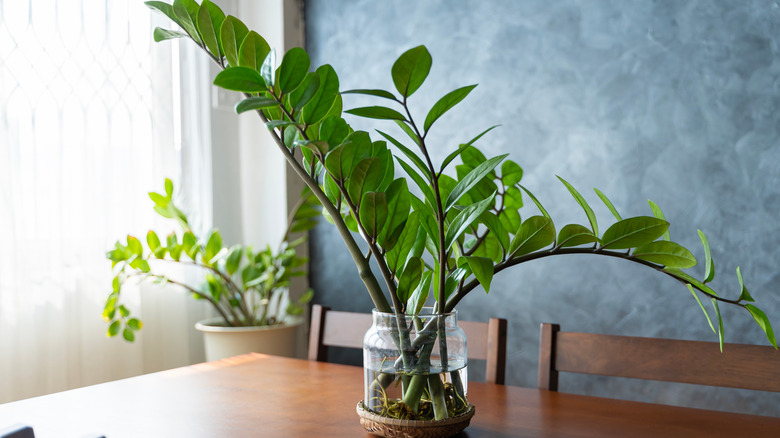Want A More Lush ZZ Plant All Year Round? Try These Watering Tips
If you're looking for new plants to bring into your home, you'll probably come across Zamioculcas zamiifolia, more commonly called the ZZ plant. This is a favorite low-maintenance houseplant for beginners because they survive in most conditions and can even tolerate a tiny bit of neglect. Some ZZ plant owners have even boasted that they only need to water theirs once a month. But that doesn't mean they won't thrive when given optimum conditions, and it's always a good idea to properly care for your ZZ plant. But like most greenery, finding the perfect watering schedule for different seasons can be challenging, especially when factoring in varying temperatures and sun exposure throughout the year — two things that have the biggest impact on how quickly your plant's soil will dry out.
Your home's humidity level, the plant's container size, and the overall quality of your soil will also influence the amount of water needed. If you want to keep your ZZ plant looking lush year-round, you can't stick to one watering schedule. There are certain tips you can follow to help make sure your plant not only survives but thrives. One is to not overwater, especially since ZZ plants are drought tolerant and susceptible to root disease. To ensure your ZZ's leaves stay beautiful every season, just be aware of how the factors in your environment change throughout the year.
Adjusting your watering schedule with the seasons
ZZ plant soil should dry out completely before it is watered again, so slow down your schedule in the winter. You can usually wait three to four weeks between waterings when the temperatures dip to extreme digits because your plant's growing rate is already in a dormant state. Resisting the urge to overwater is crucial when it is resting since water will only cause more damage. Be aware of your plant's container size. If it is larger, water less frequently as it will hold a lot of moisture. In the summer, when temperatures increase and water quickly evaporates, increase your watering schedule to every two to three weeks, depending on things like soil and sun exposure.
Make sure that the soil is dry all the way down to the root before adding more moisture. A good way to test this is to insert a wooden stick or chopstick into the soil. If there is no water mark on the wood when you pull it out, you'll know the soil is ready to be watered. When you really get to know your plant, you may be able to tell it needs water by how heavy the pot is to lift, as dryer soil will be lighter. No matter what your schedule looks like, you should always keep an eye on your plant's health and adjust its watering so that you'll never have to bring your dying ZZ plant back to life.

